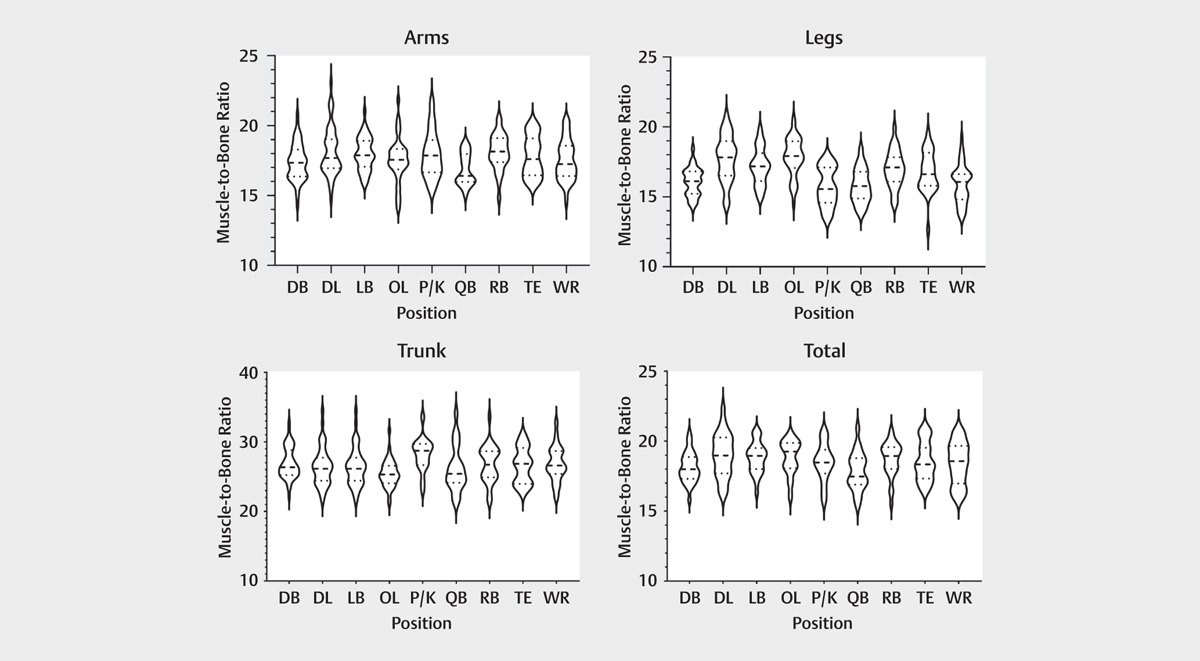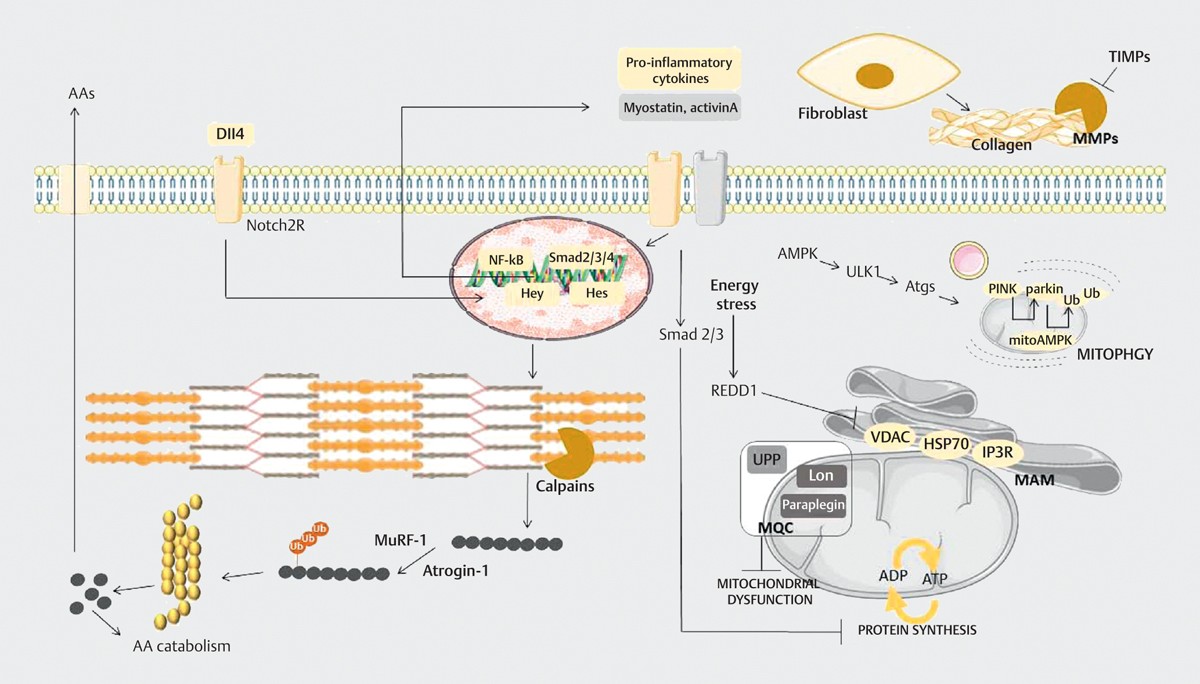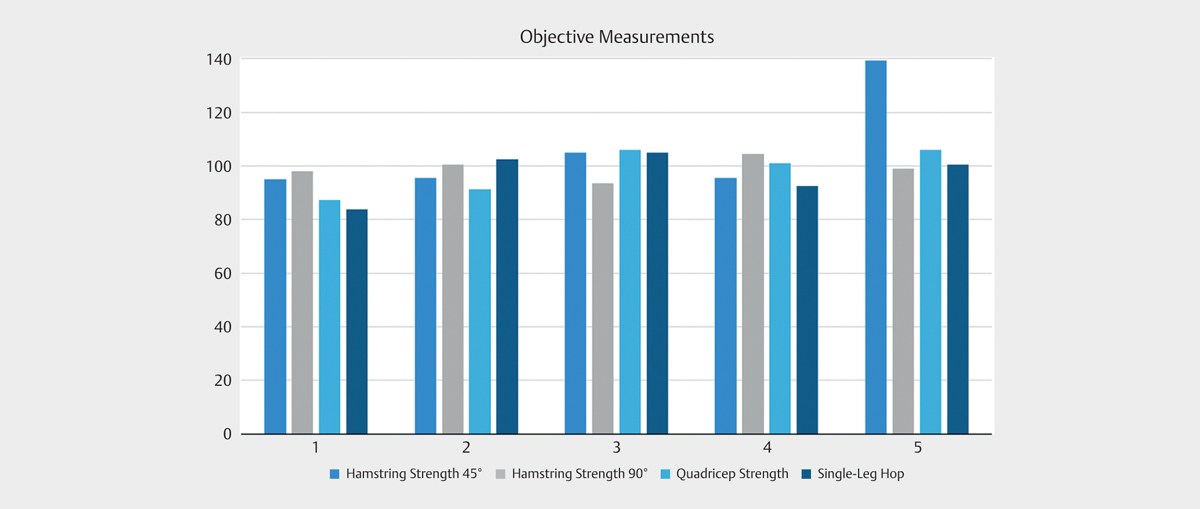
运动医学 ○ 精选论文
International Journal of Sports Medicine
Positional Differences in Muscle-to-bone Ratio in National Football League Players
Donald R Dengel, Nicholas G Evanoff
The purpose of the present study was to examine the muscle-to-bone ratio (MBR) in National Football League (NFL) players. Three hundred and forty-six NFL players had their total body lean, fat and bone masses determined using dual X-ray absorptiometry and were compared to 228 age-matched, healthy male controls. Compared to the control group, NFL players had a significantly lower percent total body fat (17.90±6.92 vs. 22.93±8.96%, p=0.053), but significantly greater total fat mass (19.76±11.29 vs. 17.84±12.11 kg, p<0.0001), lean mass (84.55±8.75 vs. 55.3±11.79 kg, p<0.0001), bone mineral content (4.58±0.45 vs. 2.91±0.67 kg, p<0.0001), and bone mineral density (1.61±0.11 vs. 1.26±0.21 g/cm2, p<0.0001). NFL players had greater arm MBR (17.70±1.47 vs. 16.48±1.88, p<0.0001) than controls; however, both trunk (26.62±2.55 vs. 31.56±4.19, p<0.0001) and total (18.50±1.31 vs. 19.12±1.88, p<0.001) MBR were lower in NFL players. Leg MBR was not significantly different between NFL players and controls (16.72±1.53 vs. 16.85±1.87, p=0.34). When NFL players were categorized by their offensive or defensive position for comparison, no differences in total MBR were observed. However, leg MBR varied greatly among NFL players by position. It is possible that regional differences in MBR in the NFL players may be related to the demands of that position.

International Journal of Sports Medicine
Protein Turnover in Skeletal Muscle: Looking at Molecular Regulation towards an Active Lifestyle
Rita Pinho Ferreira, Jose Alberto Duarte
Skeletal muscle is a highly plastic tissue, able to change its mass and functional properties in response to several stimuli. Skeletal muscle mass is influenced by the balance between protein synthesis and breakdown, which is regulated by several signaling pathways. The relative contribution of Akt/mTOR signaling, ubiquitin-proteasome pathway, autophagy among other signaling pathways to protein turnover and, therefore, to skeletal muscle mass, differs depending on the wasting or loading condition and muscle type. By modulating mitochondria biogenesis, PGC-1α has a major role in the cell’s bioenergetic status and, thus, on protein turnover. In fact, rates of protein turnover regulate differently the levels of distinct protein classes in response to atrophic or hypertrophic stimuli. Mitochondrial protein turnover rates may be enhanced in wasting conditions, whereas the increased turnover of myofibrillar proteins triggers muscle mass gain. The present review aims to update the knowledge on the molecular pathways implicated in the regulation of protein turnover in skeletal muscle, focusing on how distinct muscle proteins may be modulated by lifestyle interventions with emphasis on exercise training. The comprehensive analysis of the anabolic effects of exercise programs will pave the way to the tailored management of muscle wasting conditions.

Sports Medicine International Open
Nonoperative Treatment of Single-Tendon Proximal Hamstring Avulsions in Recreational Athletes
Olivia J. Bono, Julianne Forlizzi, Sarav S Shah, Christopher R. Nacca, Eric Manz, Katharine Ives, Suzanne L. Miller
The purpose of this study was to evaluate the patient-reported and objective functional outcomes of those patients who underwent nonoperative management of a single-tendon retracted proximal hamstring avulsion. A retrospective case series of consecutive patients with an MRI-confirmed diagnosis of single-tendon proximal hamstring avulsion treated nonoperatively with at least one year of follow-up was performed. Patient-reported outcome measures (PROMs) including SF-12v2, Lower Extremity Functional Score (LEFS), Hip Outcome Score-activities of daily living and sport subscale (HOS-ADL, HOS-SS) were prospectively collected. Objective measurements included strength testing of the affected and unaffected limbs with a handheld dynamometer and single-leg hop test. Student’s t-tests were used to determine differences between limbs. Eleven of fourteen patients were available for PROMs (79%); five completed functional testing. Subjective scores revealed a mean SF-12v2 mental component score of 56.53±8.2, and a physical component score of 50.1±12.7. LEFS was 84%±19.8, HOS-ADL 87.9%±17.2, and HOS-SS 80.9%±24. The differences between limbs were not statistically significant for strength at 45 or 90 degrees of knee flexion, nor for single-leg hop distance. Patients in a non-professional athlete population who undergo nonoperative management of single-tendon retracted proximal hamstring avulsions can expect good subjective and objective outcomes.

